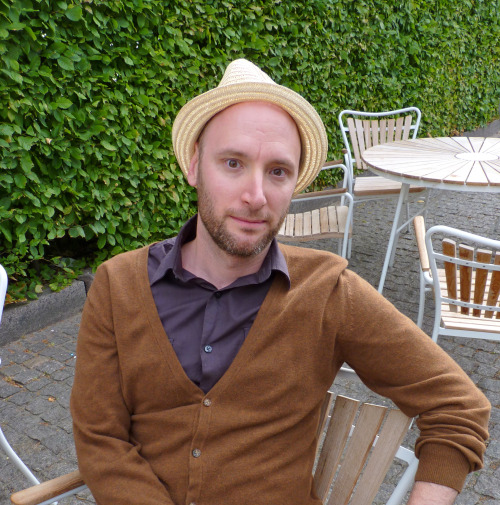
Gregory Howard and I met in the late 90s when we’d both transplanted ourselves from large cities to the cornfields of Illinois to study fiction with intimidatingly smart teachers and to intern in literary publishing. Greg had come from a background of Jesuit boy’s school, literature-and-gender studies at Boston College, the mid-90s Boston indie and punk scenes, and a job at Brookline Booksmith, all of which made him about the most literary person I’d ever met. He introduced me to the work of Georges Perec and to Calvino’s Six Memos. Since then we’ve always had many favorite writers in common. He holds an M.A. from Illinois State, a PhD from the University of Denver, teaches on the creative writing faculty at the University of Maine, and has a debut novel—Hospice—just published by FC2, which gave us this chance to catch up.
Hospice is a comic novel, an absurdist novel, a fairly dark psychological novel, and what I would call ambulatory—not a story about walking but a story that itself likes to walk. Its three parts cover different periods in the life of its protagonist, Lucy: 1) the disappearance of her brother from her childhood, and the return of someone who looks like her brother but isn’t; 2) her ill-fated period of babysitting, first for an imaginary dog and then for two very strange children; and 3) her time working in a hospice, during which she becomes obsessed with finding a fabled hospital that travels from place to place and that is apparently a portal to the afterlife.
The book is full of “tales,” like a storybook, but the larger narrative that contains them is anything but simple. Events seem random but take on meaning, but then lose meaning and seem random again. Characters are not really sane or insane but rather some variation of both. As the title suggests, death looms, and is often welcome, or sought, or possibly has already arrived, and we are on the far side of the mirror. Not that the book actually says that, but that’s the feeling it gives me: life has been flipped, and now we are going to go through it all again, backwards.
—Martin Riker
I. GOOD-BYE, GOOD-BYE, GOOD-BYE.
THE BELIEVER: Before we talk about the book I thought I’d ask about your complicated relationship to the concept of “home,” which you write a lot about in Hospice and elsewhere. In your essay “The Object is Always Magic,” for example, you write: “The uncanny, we know from Freud, is that feeling of the unheimlich, or the unhomely—the feeling that we are not at home in our home or at home in a place we should not be...
You have reached your article limit
Sign up for a digital subscription and continue reading all new issues, plus our entire archives, for just $1.50/month.
Already a subscriber? Sign in




